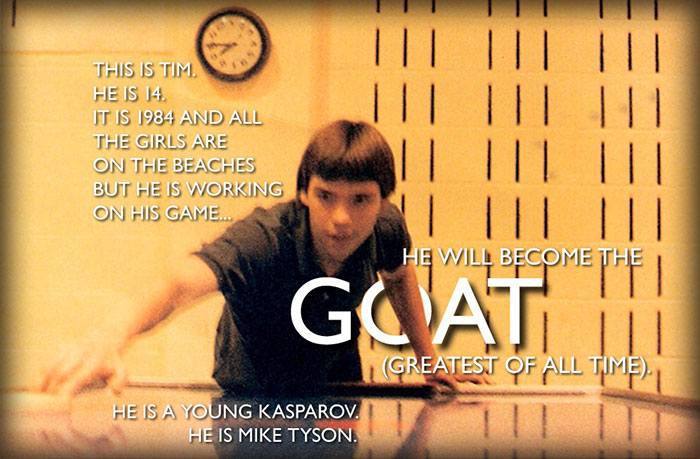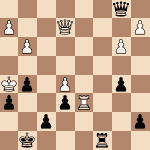What sport is described by the following quotes? “It’s boxing without the brain damage”; “It’s a really combative sport, believe it or not”; “I would equate it to a fierce battle.”
The quotes are from the opening minutes of the 2010 film Way of the Puck, a documentary about Air Hockey. One featured player is a 10-time World Air Hockey Champion, known as the “Kasparov” of Air Hockey, Dr. Tim Weissman.

Weissman created a notebook containing “strategy and notes on every single player that I’ve had great matches with or that I consider a threat.” Air Hockey allowed Weissman “to challenge myself against another human being and go head to head.” Weissman, who has a Ph.D. in Clinical Psychology, asked, “How do men obtain their social support in this society? How do they obtain the social connection that we need? Men need these contrived, competitive situations in which they can connect to other guys.”
boxing without the brain damage
Chess is also like boxing without brain damage, combative, and a fierce battle. Top chess players used to assemble notebooks—and now create databases—about their opponents’ openings and strategies. Also, like Air Hockey, competitive chess is mostly played by men, who form lifelong social connections via chess tournaments.
Both Air Hockey and chess connect to The University of Texas at Dallas (UT Dallas). UT Dallas is known for its winning chess team. But Air Hockey? The Air Hockey-chess-UT Dallas connection is through Dr. Mark Spong. In his previous position at the University of Illinois, Spong developed a three-degree-of-freedom Air Hockey robot.

Footage of that robot appears at the end of the Way of the Puck. The same footage appears in this video, where Spong discussed that both the Air Hockey robot and autonomous chessmen robots—“Proof of Concept Experiments”—allow students to develop and test algorithms. They can’t test them on a real airplane or in a nuclear power plant, but they can test them with these robots. If the Air Hockey or chess robots fail, students can try to improve them. It would be too dangerous to let students fail with an airplane or nuclear power plant.
Thus, both Air Hockey and chess not only provide competitive, social experiences for their players but are playing fields for future engineers. As explained in a second video clip of the Robotic Chess Navigational Control Team (the first video clip is here), a person would play another person (or a computer) via a web-based chess application. Then, wireless signals would be sent to the robot chessmen, who would act out the chess moves. At the time of the two videos linked above (December 16, 2011), the details of the robot chess team’s performance were being worked out. For example, a knight might squeeze by on a square’s edge or the other chessmen might move out of its way then move back into their positions after the knight passed. Each robot chessman’s base is 9 inches in diameter, and the squares at UT Dallas Chess Plaza are two foot by two foot.

In the photo taken at Chess Plaza, the green robot chessmen are representing White. Unfortunately, I could not find a video of an entire robot chess team performance. Dr. Nick Gans, now of The University of Texas at Arlington, provided this video of how one chessman (a king) moved during testing.
What chess openings are fit for a “fierce battle,” words which might describe both Air Hockey and chess? FIDE Master Graham Burgess, in his latest book An Idiot-Proof Chess Opening Repertoire (Gambit Publications, 2020), promises “an ambitious repertoire: we put our pieces in the centre and are looking for a fight.” For example, as explained also in this video, Burgess suggests sacrificing a pawn when playing Black against the Reti opening. 1. Nf3 d5 2. c4 d4 3. b4 and now what do you think Burgess recommends? 3…g5. The move seems surprising, but it aims for kingside expansion. Some possible follow-up moves include 4…Bg7 (to support the d-pawn), …e5 (to support the d-pawn) and possibly a later …g4, to kick the N on f3. If White takes the pawn immediately, 4. Nxg5 e5 wins back the pawn, because when White defends the knight with 5. d3, which allows the B on c1 to protect the N, then Black captures the b-pawn, 5…Bxb4+ and material is equal. White has better choices on move 4. Then, Black must be prepared to sacrifice the g-pawn with the compensation of having strong center pawns (on d4 and e5) and good play.
For a more detailed review of An Idiot-Proof Chess Opening Repertoire, go to the British Chess News at this link.

I play both games and I enjoy them equally. This is an awesome write-up about chess and air hockey. Thank you for this delightful read. Looking forward for more of this.